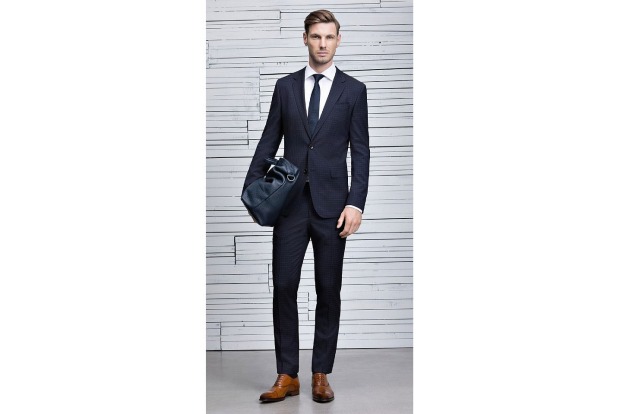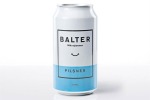Men's suits can be traced back to the 17th century, when King Charles II imposed his power through a strict dress code in the courts. Edwardians developed the lounge suit in the 1900s, preceding 1920s Gatsby gents who went elaborately Dandy with wide-legged trousers, pastels and statement checks.
The '40s saw pant waists rise and smoking jackets slink in, before WWII dispelled all sense of luxury, as clothing rations lent their utilitarian effect to suits in the '50s.
But it was the '60s that saw today's modern suit emerge: those Italian maestros of needle and thread who saw the importance of tailoring a flawlessly fitting suit for men.
Canvassing opinion

Suits are an investment piece, and warrant much planning when buying off the rack. The most important quality is a jacket that has a full canvas. A canvassed jacket has layers of material (wool, horsehair or camel) that sit between the outer fabric and the inner lining of a suit jacket. The style holds its shape after multiple wears and drapes against the body.
The second option is a half-canvas, where the tailor canvasses in the more visible top portion of the jacket for superior drape, cutting costs compared to the full canvas. Alternatively, cheaper suits have a lining that is fused to the fabric, which involves little support and a standard drape. Pinching the layers of fabric between the button holes will uncover if the jacket is canvassed.
The lapel and collar

There are three main lapel types: peak, shawl and notch. The peak lapel is the most expensive to make - a pointed cut, commonly found on double-breasted suits. It's a formal look and has a natural widening affect on the shoulders. If you're slim and narrow, opt for small peaks or larger peaks for larger gents. Peaks that end on the collar bone make you look taller and leaner, especially in darker tones.
The notch lapel is the most common. Made famous on the single-breast suit, the width and angle varies between brands. The trend at the moment is for slim lapels and in a contrast colour, too. For a timeless, goes-with-everything suit opt for a two-button, notch lapel suit that lines up with the shoulders to flatter either skinny guys or gym junkie frames.
The shawl lapel gets its heritage for the smoking parlours of the Victorian upper class, before modern tailors killed off the peak lapel for the shawl when reworking the tuxedo. Today, you'll find the black-tie only shawl lapel working its way onto window pane checked suits and more traditional corporate attire. The curving line of the shawl adds a little bit of Dandy to a stuffy office look, and is your best bet for formal wear.
Counting thread and fabric

Wool is the ultimate suit fabric and differs according to thread count: the number of times that the wool has been twisted when it is made. The higher the number, the finer and lighter the cloth will be. The count affects the durability and softness and gives your suit asubtle brilliance.
The optimal thread count is a super 100 to 120. Once you're in the 200s, however, the suit becomes more fragile due to its purity, so consider this when looking for a longer-lasting, everyday suit.
Cashmere is very luxurious. Blended with wool, it gives a sheen to the suit, made famous by Italian tailors. But it's a contrast to the matte wool finishes favoured by the Brits and isn't liked by everyone.
Linen is perfect for summer. It does crease easily but this forms character so don't get caught up by it. A heavier linen will retain its shape better, too. Keep these suits for parties and day wear.
Seersucker, like linen, is designed to bunch a little giving it a casual, textural look. Ventilative and light, it's also great for warm weather.
The fit

There are four basic must-knows in regards to the fit.
1. The fit across the shoulders needs to be neat and natural. The sleeve or arm should fall from the tip of the shoulder edge to the wrist. Too wide on the shoulder and you look out of proportion; too short and it will pinch and sit up high on your shoulder making you look squished.
2. The trouser conventionally comes in a medium break (where the pants fall on your shoes). To avoid clumsy bunching, a slim trouser leg should finish just on the shoe, without covering your laces. A shorter breaker is very on trend at the moment for a cropped, straight-legged look, while a longer breaker is super traditional for corporate environments.
3. The length of the jacket should finish no longer than mid-way down, and no shorter than the top of your backside. Too long and it becomes more of a sports coat; too short and it becomes feminine.
4. Sleeve length should finish between nine centimetres above the knuckle of the thumb. Give it another two centimetres you're wearing cufflinks or a nice a patterned shirt where you want to show of the cuff.
Timeless suits for men

The three-piece suit is the most traditional. It's a great formal choice and creates superb layering opportunities for winter, with a classy waistcoat. Take your jacket off and a tailored look remains.
The plaid suit or check suit was once seen too preppy and casual. Today, it has made a resurgence as a work-ready piece and standout party-goer. Darker wool hues are great for more formal occasions and winter; while pops of bright colour are designed for summer and the more Dandy at heart.
The blue suit is the new black suit for men. The darkness of the hue in navy is perfect office attire, while a cobalt or electric blue provides a playful look for any off-duty activities; be it a wedding or some dapper fun on the weekend.
The double-breasted suit once spoke of the power '80s, but has been revived. Lean men thrive on this style as it adds width to your frame with the double layering of fabric. Go for a peaked lapel to match the classy buttons.
The dinner suit is perfect black-tie attire with a bow tie. Velvet fabrics and satin or pony hair lapels sex-up this classic look, and don't be shy of mixing – even contrasting the colour of pants and jacket or the lapel colour against the coat.
The grey suit is neutrally-hued staple for any gent. Work lighter marl and pastel shades for summer; while darker greys and charcoals are perfect for the winter months.
The pinstripe suit is a must for broader men. The wider the gap between each stripe the more casual and pyjama-looking the pattern becomes, however. Stick to subtle, tonal-coloured stripes that are relatively thin for a standout business suit.
This story was originally published on D'Marge.




































































